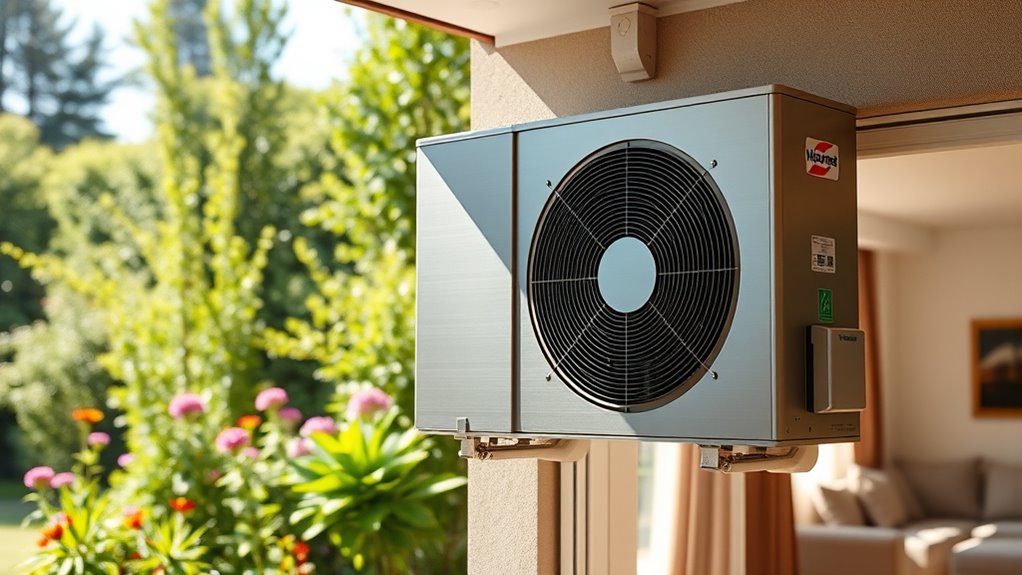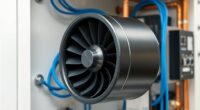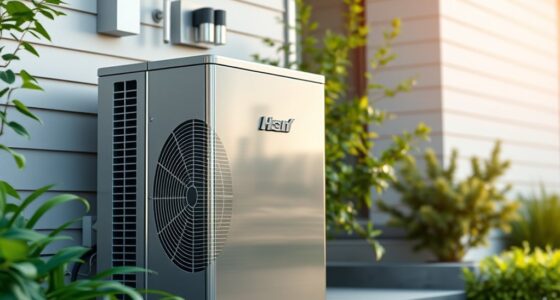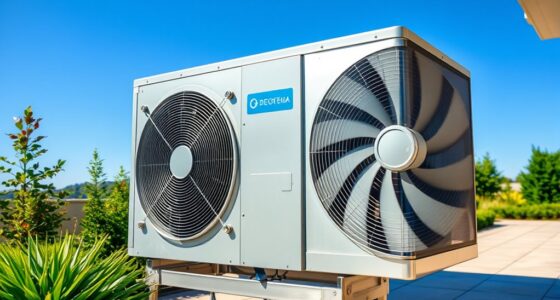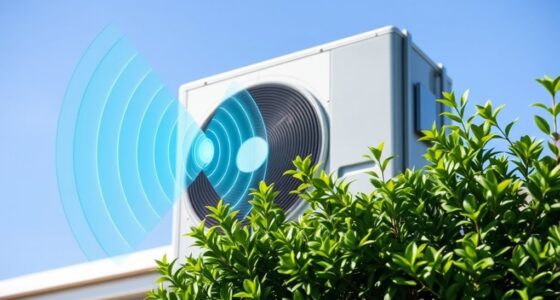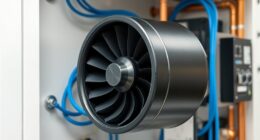Heat pumps work as dual-function systems by transferring heat to warm your home in winter and removing heat to cool it in summer. They operate on a refrigeration cycle, reversing refrigerant flow to switch between heating and cooling modes. This flexibility offers energy-efficient climate control year-round. If you’d like to understand how they seamlessly adapt to seasons and which options fit your needs, more details are just ahead.
Key Takeaways
- Heat pumps transfer heat from outside to indoors for heating, and from indoors to outside for cooling, using a reversible refrigeration cycle.
- They operate in two modes: heating by absorbing external heat and cooling by removing indoor heat.
- The reversing valve switches refrigerant flow, enabling seamless transition between heating and cooling functions.
- Heat pumps provide year-round climate control with high energy efficiency, reducing reliance on separate heating and cooling units.
- Proper system design and maintenance ensure optimal performance of their dual heating and cooling roles.
How Heat Pumps Provide Year-Round Climate Control
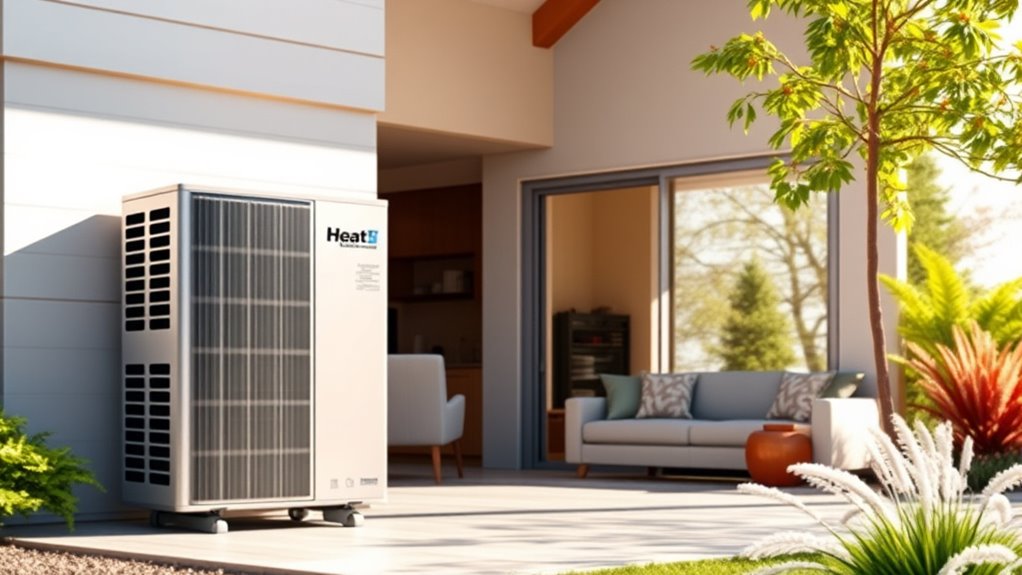
Heat pumps offer a convenient way to manage your home’s climate throughout the year by providing both heating and cooling with a single system. These versatile devices enable year-round climate control by switching modes seamlessly. In winter, heat pumps extract heat from ambient air—even at low temperatures—and transfer it indoors, maintaining a steady, comfortable temperature. During summer, they reverse the process, removing heat from inside your home and releasing it outside to cool your space effectively. This reversible mechanism, controlled by a reversing valve, allows you to easily switch modes based on your needs. By relying on ambient air rather than traditional heating methods, heat pumps enhance energy efficiency and help you achieve consistent indoor comfort without the hassle of multiple systems. Additionally, advancements in smart controls allow for better optimization and monitoring of system performance, further improving energy savings and comfort.
The Mechanics Behind Heating Mode Operation
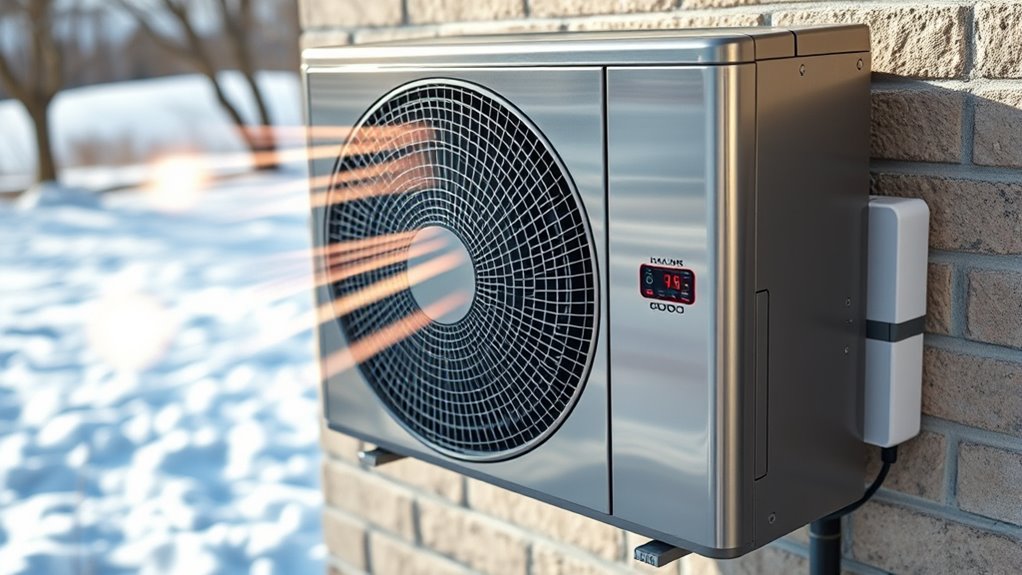
When your heat pump switches to heating mode, the outdoor coil absorbs heat from the air, even at cold temperatures. The refrigerant then gets compressed, raising its temperature and pressure before releasing heat indoors. This cycle, controlled by the reversing valve and other components, keeps your space warm efficiently. Efficiency measurement is key to understanding how well your heat pump performs in heating mode, and practicing stillness during operation can help enhance your mental clarity and focus, supporting better understanding of your system’s performance. Recognizing early symptoms of malfunction can enable timely maintenance and prevent system failure. Additionally, understanding cultural and regional breakfast traditions can offer insights into how different environments influence heating and cooling needs in various climates.
Heat Absorption Process
In heating mode, the outdoor coil functions as an evaporator, absorbing heat from the surrounding air even at temperatures at or below freezing. The refrigerant inside the evaporator coil absorbs this heat transfer, causing it to transform from a low-pressure liquid into a gas as it absorbs heat during evaporation. As the refrigerant heats up, its temperature rises, enabling efficient heat absorption despite cold conditions. The process involves a delicate balance between the liquid refrigerant cooling through the expansion valve and turning into gas. This gas then moves to the compressor, where compression raises its temperature and pressure for indoor heat transfer. This cycle repeats seamlessly, providing reliable heating even in low outdoor temperatures. Proper maintenance of refrigerant levels is crucial for optimal performance of the heat pump system. Additionally, understanding heat transfer mechanisms can help optimize system efficiency and longevity, especially considering energy transfer processes that influence overall system effectiveness. Regular monitoring of system components ensures consistent operation and prevents potential malfunctions.
Refrigerant Compression Cycle
The compressor plays a crucial role in the refrigerant cycle during heating mode by actively compressing the refrigerant gas, which raises its temperature and pressure. This high-pressure, high-temperature refrigerant then flows through the condenser coil, where heat transfer occurs, warming your indoor air as it releases heat and condenses into a liquid. Before re-entering the evaporator, the refrigerant passes through the expansion valve, which reduces its pressure and temperature. This cooling process prepares it to absorb heat from the outdoor environment in the evaporator coil. The compressor continuously cycles the refrigerant, maintaining steady pressure and flow. This cycle ensures efficient heat transfer, enabling your heat pump to deliver consistent warmth during heating mode. Additionally, ongoing research into AI Security emphasizes the importance of monitoring and safeguarding these systems against vulnerabilities to ensure safe and reliable operation. Proper maintenance of these components also contributes to the system’s efficiency, particularly as technological advancements continue to improve overall performance.
Heat Release Mechanism
During heating mode, the heat pump’s outdoor coil absorbs heat from the surrounding air by causing the refrigerant to evaporate into a gas, even at low temperatures. This refrigerant absorbs heat through heat transfer during evaporation. The compressor then compresses the refrigerant gas, raising its temperature profoundly. The high-pressure, high-temperature refrigerant flows to the indoor condenser coil, where it releases heat into your home during heat exchange, warming the indoor air. After heat transfer, the refrigerant passes through an expansion valve, reducing its pressure and temperature before returning to the outdoor coil to repeat the cycle. The reversing valve switches refrigerant flow, enabling seamless shift between heating and cooling modes. This process efficiently transfers heat, providing warmth during winter. Additionally, understanding the heat release mechanism helps in maintaining optimal system performance and longevity.
How Cooling Mode Transforms Indoor Comfort
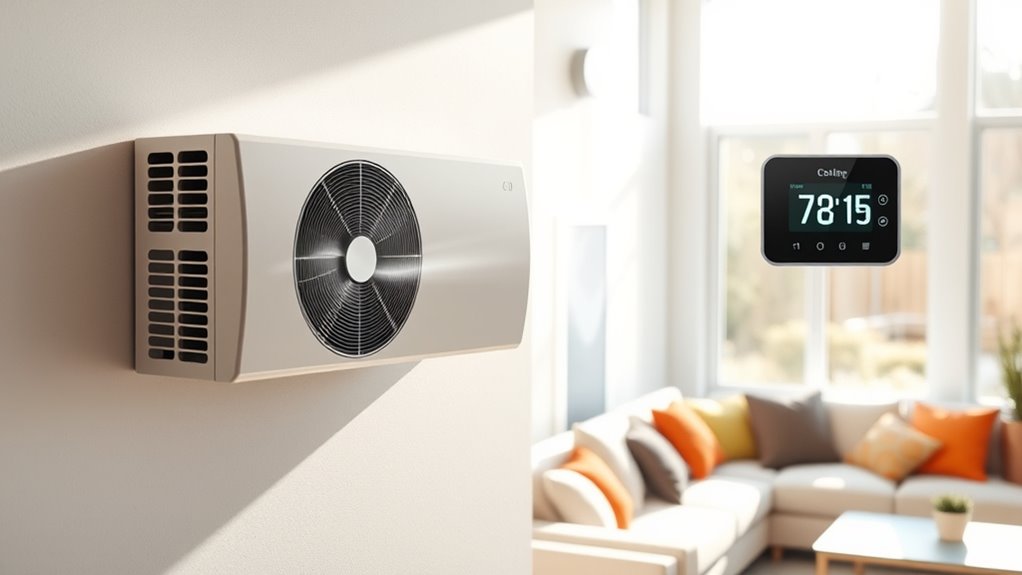
When you switch your heat pump to cooling mode, it reverses refrigerant flow to pull heat from inside your home and push it outside. This process cools the indoor air and reduces humidity, making your space more comfortable. Quiet operation guarantees you stay cool without disruptive noise during warmer months. Additionally, energy efficiency features ensure optimal performance and lower energy bills. Proper maintenance further enhances system longevity and efficiency over time. Regularly inspecting and cleaning filters can also help maintain optimal performance and extend the lifespan of your heat pump. Incorporating tuning techniques similar to automotive upgrades can optimize your system’s efficiency and responsiveness.
Heat Extraction Process
In cooling mode, the reversing valve switches the flow of refrigerant, enabling the evaporator coil to absorb heat from your indoor air. The refrigerant, which is cold and low-pressure, evaporates into gas as it absorbs heat through the coil, lowering indoor temperature and humidity. This heat transfer process causes the refrigerant’s pressure and temperature to rise. The compressor then compresses the refrigerant gas, further increasing its pressure and temperature, preparing it for heat rejection outside. Inside, the outdoor coil acts as a condenser, releasing heat to the environment as the refrigerant condenses back into a liquid. This cycle efficiently pulls heat from your indoor space, creating a cooling effect and maintaining a comfortable indoor climate. Proper heat pump tuning ensures optimal performance and energy efficiency during this process. For long-term efficiency, regular maintenance of refrigerant levels and system components is essential to sustain optimal operation.
Indoor Air Cooling
Heat pumps switch to cooling mode by reversing the flow of refrigerant, which allows the indoor coil to absorb heat from your air. The refrigerant flows through the evaporator coil inside, pulling warmth from the indoor air and lowering its temperature. Proper installation and system maintenance are essential to ensure optimal performance and safety. Simultaneously, the system expels this heat outside via the condenser coil. As it cools, the heat pump also reduces indoor humidity, providing dehumidified air that feels more comfortable and less sticky. This process improves indoor air quality while maintaining a steady, comfortable temperature. Modern HVAC systems adjust refrigerant flow and fan speeds to ensure consistent cooling performance. Energy efficiency is a key benefit of heat pumps, as their ability to switch between heating and cooling modes helps reduce overall energy consumption. Quiet and efficient, heat pumps transform indoor air, making your environment cooler, drier, and more comfortable during hot weather. Additionally, some models utilize advanced refrigerant technology to enhance energy efficiency and cooling capacity.
The Different Types of Heat Pumps and Their Uses

There are several main types of heat pumps, each suited to different applications based on their heat transfer sources. Air-source heat pumps transfer heat between indoor spaces and outside air, making installation straightforward and offering good energy efficiency for heating and cooling. Water-source heat pumps draw heat from water bodies like lakes or ponds, providing high efficiency in suitable locations. Geothermal or ground-source heat pumps use underground temperatures for reliable performance, though they require more complex installation. These systems are ideal for consistent heating and cooling, harnessing renewable energy from the earth. Additionally, advancements in system design have improved the efficiency and durability of these systems, making them more accessible for various applications. Furthermore, ongoing innovations in heat pump technology continue to enhance their performance and reduce operational costs. Proper system maintenance also plays a critical role in maintaining optimal efficiency and extending the lifespan of heat pump systems. Regular upkeep can help prevent issues caused by environmental factors that affect system performance over time.
Key Benefits of Using a Dual-Function Heat Pump
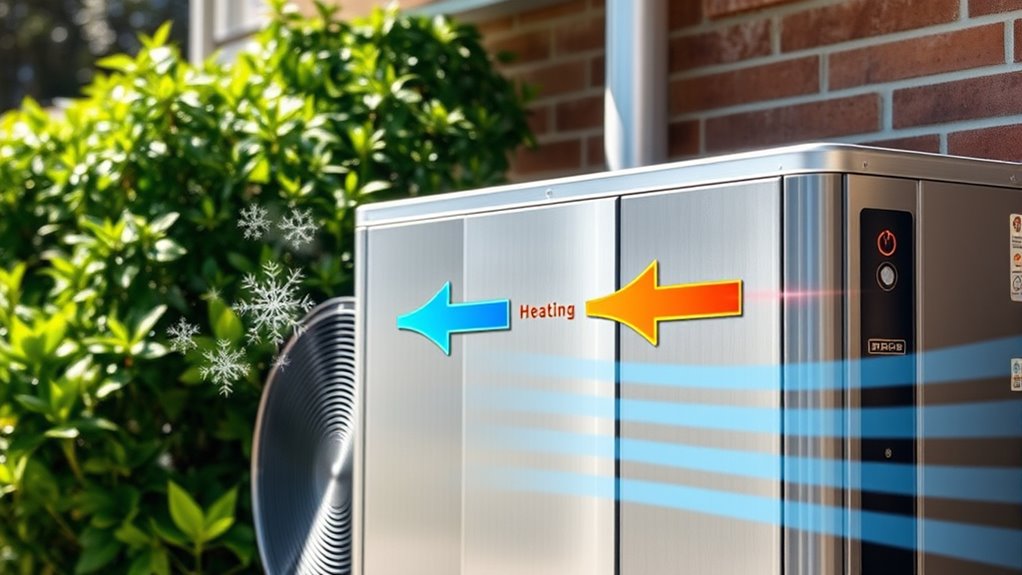
A dual-function heat pump offers the convenience of providing both heating and cooling from a single system, which can substantially save you space and reduce installation costs. With heat pumps that switch seamlessly between heating and cooling modes, you gain better control over your home climate. Their high energy efficiency helps lower utility bills and minimizes your environmental impact, supporting sustainable living. During seasonal change, these systems adapt easily, maintaining indoor comfort without the need for separate units. By efficiently transferring heat indoors or outdoors, dual-function heat pumps simplify home climate control while reducing energy consumption. This combination of versatility and eco-friendliness makes them an excellent choice for those seeking comfort and savings year-round.
Factors to Consider Before Installing a Heat Pump

Before installing a heat pump, it’s important to evaluate your local climate, as these systems perform best in moderate temperatures and may struggle below freezing. Climate considerations are vital for optimal system performance and seasonal efficiency. Assess your existing HVAC infrastructure to determine whether a ductless or ducted system suits your home’s layout and zoning needs. Consider the initial costs, especially for geothermal or water-source models, which tend to be higher but offer better energy efficiency. Check your electrical system compatibility to guarantee it can handle the heat pump’s power requirements. Conduct a property analysis to evaluate your space and heating/cooling demands. Consulting a professional installer can help you make informed decisions, ensuring your chosen system aligns with your climate, budget, and energy goals for reliable, efficient operation.
The Environmental Impact of Heat Pump Technology
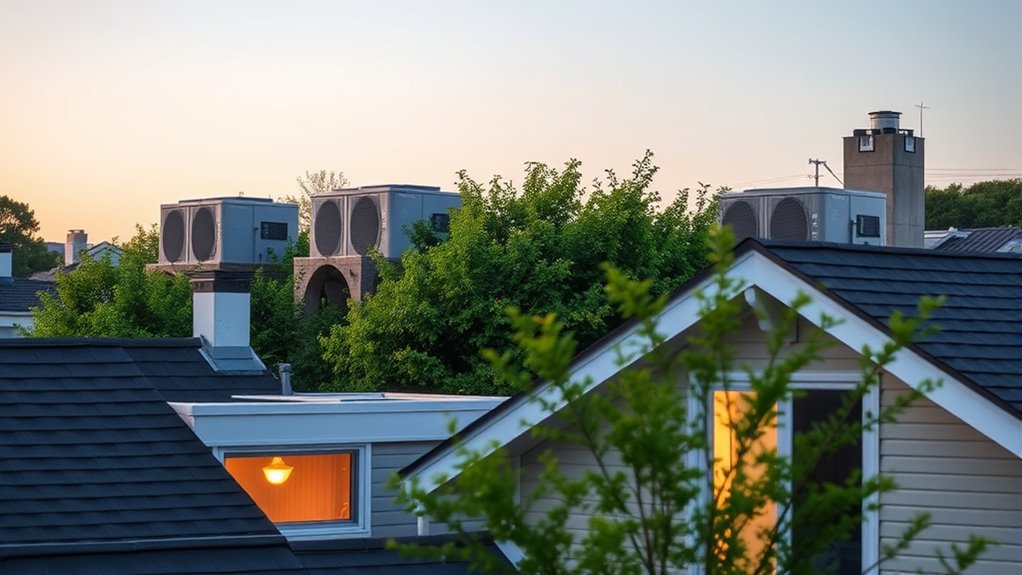
Heat pump technology offers notable environmental benefits by considerably lowering carbon emissions compared to traditional HVAC systems. When powered by renewable energy, heat pumps become even more eco-friendly, substantially reducing your carbon footprint and overall environmental impact. Their high energy efficiency, often producing 3-4 units of heat per unit of electricity, means less energy consumption and lower greenhouse gas emissions. Geothermal heat pumps, which utilize stable underground temperatures, further decrease energy use and minimize reliance on fossil fuels. By adopting this technology, you contribute to improved air quality and support sustainable living initiatives. Overall, heat pumps help decrease greenhouse gases, reduce environmental impact, and promote a cleaner, greener future for both residential and commercial buildings.
Maintenance Tips for Optimal Performance

To keep your heat pump running efficiently, regular maintenance is essential. Proper upkeep ensures peak system efficiency and prolongs its lifespan. Start by checking and replacing air filters every 1-3 months to maintain good airflow. Schedule professional maintenance annually to inspect refrigerant levels, clean coils, and verify all system components are working correctly. Keep outdoor units clear of debris, leaves, and snow to prevent airflow obstructions. Additionally, inspect and clear condensate drains to avoid water buildup, mold growth, or damage. Using a programmable thermostat helps reduce unnecessary strain on your system. Regular maintenance not only boosts performance but also prevents costly repairs down the line.
- Check and replace air filters regularly
- Schedule professional maintenance annually
- Keep outdoor units free of debris
- Inspect and clear condensate drains
Determining if a Heat Pump Fits Your Home Needs
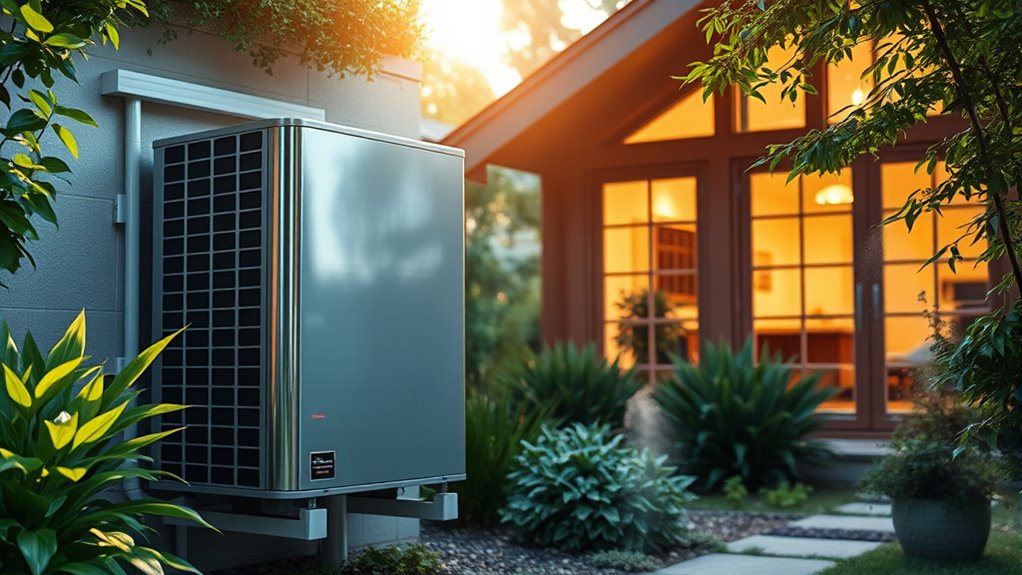
Evaluating whether a heat pump is right for your home involves considering your local climate, as these systems work best in moderate temperatures and may need supplementary heating in very cold conditions. A properly sized heat pump guarantees effective climate control, so assess your home’s insulation and existing HVAC systems to determine if it can meet your heating and cooling needs efficiently. For retrofit projects or homes with ductless setups, flexible zoning and easier installation make heat pumps a practical option. Keep in mind that climate conditions influence energy efficiency; colder climates might require additional heating sources. Consulting with HVAC professionals helps analyze your property’s layout and climate, ensuring you select the right system size and type for ideal performance and comfort year-round.
Frequently Asked Questions
How Do Heat Pumps Work for Heating and Cooling?
You might wonder how heat pumps manage both heating and cooling. They work by transferring heat from outside to inside for warmth, and reversing that process for cooling. When heating, the refrigerant absorbs outside heat and releases it indoors. For cooling, the system switches direction, removing indoor heat and expelling it outside. This seamless switch is thanks to the reversing valve, making heat pumps efficient year-round climate control.
How Does a Dual Heat Pump Work?
A dual heat pump works by reversing the refrigerant flow to switch between heating and cooling modes. You control it with a reversing valve, which directs the heat transfer process. In winter, it absorbs heat from outside and releases it inside. During summer, it expels indoor heat outside. The compressor boosts refrigerant temperature for efficient heat transfer, providing you with year-round comfort effortlessly.
How Do a Heat Pump and Furnace Work Together?
Sure, because relying on just one heating method would be too simple, your system combines a heat pump and furnace. When the weather’s mild, the heat pump handles warming and cooling efficiently. As temperatures drop, the furnace kicks in to save the day. It’s like having a backup superhero, switching seamlessly to keep your home comfortable and energy bills in check without you lifting a finger.
What Is a Dual Heating and Cooling System?
A dual heating and cooling system, like a heat pump, is a single unit that handles both functions by reversing refrigerant flow. You switch between heating in winter and cooling in summer, saving space and costs. It uses components like a reversing valve, compressor, and coils to transfer heat into your home or outside, depending on the season. This makes managing indoor climate simple and efficient year-round.
How Does a Dual HVAC System Work?
You see, a dual HVAC system works by using a heat pump to switch between heating and cooling modes. It moves heat inside during winter and outside in summer. When you want heating, the system absorbs outdoor heat and releases it inside. For cooling, it does the opposite. The reversing valve changes the refrigerant flow, letting you enjoy comfortable temperatures all year without needing separate systems.
Conclusion
Heat pumps truly are game-changers for year-round comfort, offering efficient heating and cooling in one system. While some believe they can replace traditional HVAC units entirely, it’s worth investigating whether your home’s climate and needs align. With proper maintenance and careful consideration, you can access their full potential, saving energy and reducing your environmental footprint. So, why not explore further? You might find that a heat pump is the smart, sustainable choice for your home’s comfort needs.
